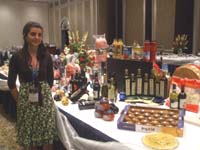 |
| Subhash Arora explaining the wine regions of italy |
The
5 wine co-operatives, Caviro, Cavit, Cantina de Soave, Cantine Due Palme
and Chianti Geografico were part of the 15 members that include co-operatives
for cheese, meats, olive oil, vegetables and fruits.
Ten wines were presented,
two each from these co-operatives.' We selected 10 wines out of a total
of about 50 labels that were being showcased at this event,' said Subhash
Arora, President of the Indian Wine Academy and editor of delWine newsletter,
who was conducting these workshops in Delhi and Mumbai. 'The idea is
to showcase various indigenous grapes from as diverse regions as possible.
Italy has a unique and enviable position of growing a large number of
unique grape varieties which offer interesting wines.'
 |
| A tasting session |
The varietals included
the generally known Sangiovese to Garganega of Soave, Corvina of Valpolicella,
Negroamaro, Malvasia and Primitivo of Puglia, Montepulciano of Abruzzo,
Teroldego of Trentino and Vernaccia of San Gimignano.
Highlighting the
confusion in the appellation of Italian regions, Arora cautioned his
audience not to oversimplify and assume that a DOCG wine would always
be better than say, a DOC from another region. IGT was even more confounding,
with prices that could vary from $2 to upwards, to even $200. Knowledge
of the producer and a frequent tasting of their various varietals as
far as possible is the best way of training your palate and comparing
various qualities, he added.
 |
| An Italian Feast for the Eyes |
Explaining the power of the 600+ co-operatives, he said that about 50%
of Italian wine production was in the hands of these co-operatives, including
bulk and low-end supermarket wines. They might not produce wines like
the boutique wineries, but the resources and the resultant clout make
them use innovation, research and equipment to standardise their wines
and offer them at very good prices.
Arora went on to explain the benefits of dealing with such co-operatives.
Imports from them with their own or private labels was the obvious advantage,
but with supermarkets gearing up for marketing wines, they offer a great
partnership to importers and producers alike to strengthen their position
in their area of expertise.
The following wines were tasted both in Delhi and Mumbai, with minor
variations:
| 1. |
Altemasi Mill. Metodo Classico Trentino DOC 2000 Cavit |
| 2. |
Rocca Sveva Soave Classico Sup.DOCG 2006 Cantina di Soave Castelcerino |
| 3. |
Vernaccia di S. Gimignano DOCG 2007 Chianti Geografico |
| 4. |
Volorosso Montepulciano d'Abbruzzo DOC 2006 Caviro |
| 5. |
Volorosso Merlot Friuli Grave DOC 2007 Caviro |
| 6. |
Bottega Vinai Teroldego Rotaliano DOC 2006 Cavit |
| 7. |
Primitivo Salento IGT Rosso Ettamiano 2004 Cantine Due Palme |
| 8. |
Salice Salentino Rosso DOC 2004 Selvarossa Riserva Cantine
Due Palme |
| 9. |
Brunello di Montalcino DOCG 2002 Chianti Geografico |
| 10. |
Rocca Sveva Amarone Valpolicella 2003 Cantina di Soave |
 |
| Reps. from Caviro, Cantina di Soave, CAvit, Chianti Geografico and Cantina Due Palme |
Whereas Amarone would always stand out in such a spectrum, the surprise
package was a Salice Salentino DOC 2004 Selvarossa from Cantine Due Palme,
which was loved by every taster. Pity, they did not bring the 2003 which
has won 3 glasses from Gambero Rosso, but universally such wines get
picked up by wine buyers immediately so one had to be content with the
2-glass winning 2004.
The exhibitors were quite impressed by the selection of wines and the
way the workshop was organised and conducted. Commented a participant,'
I have never tasted 10 Italian wines at a session where I loved all of
them.'
The staff at the Taj in Delhi and Mumbai did a very professional
job in terms of serving at the right temperature, pouring and other nuances
that go with the tastings. |